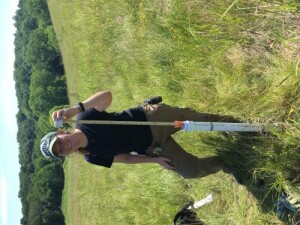Restoring Disturbed Landscapes
While urban sprawl contributes to deforestation, many areas in the US now have more forests than they did a century – or a few decades – ago. These afforested areas are super-imposed on landscapes with a legacy of human activities, including agriculture and mining. Both abandoned agricultural lands and reclaimed mine sites feature disrupted drainage networks and altered soil profiles and properties, relative to their pre-disturbance conditions. These changes alter the partitioning of water between the surface and subsurface and may affect success and ecohydrology of reforestation efforts.
I’ve also worked on legacy effects of intensive agriculture on modern channel head positions, stream sediments impacted by acid mine drainage, and island growth upstream of dams. If humans historically altered the landscape, there is science to be done to understand how it functions now and how we might alter function through restoration activities.
Recent Research

Grad student Catherine Ruhm shows off a crest stage gage at one of the sites slated for restoration in Cuyahoga Valley National Park.
Reforesting Reclaimed Mines: In partnership with Cuyahoga Valley National Park, the FoSTER (Forest Soil and Trees Ecosystem Restoration) project aims to (1) understand why abandoned and reclaimed surface mine and quarry sites have failed to reforest and (2) study the effectiveness of new restoration efforts including deep ripping and volunteer-led tree planting. My collaborators on the project are Dr. Chris Blackwood and Dr. Christie Bahlai. If afforestation is successful, we hope to use these sites as long term ecohydrologic research laboratories, where we can watch the co-evolution of soils, hydrology, and above and below-ground ecosystems. You can hear me talk about the project in a 6 minute interview recorded in spring 2018. Catherine Ruhm completed a MS thesis characterizing the sites’ soils prior to deep-ripping, and Mike Back completed an undergraduate Honors thesis on bulk density profiles within and between of ripped areas.
- Back, M.P., Jefferson, A.J., Ruhm, C.T., Blackwood, C.B. 2024. Effects of reclamation and deep ripping on soil bulk density and hydraulic conductivity at legacy surface mines in northeast Ohio, USA. Geoderma, 442, 116788. dot: 10.1016/j.geoderma.2024.116788
- Ruggles, T.A., Gerrath, J.A., Ruhm, C.T., Jefferson, A.J., Davis, C.A., and Blackwood, C.B. 2021. Reclaimed surface mines show little progress towards native species forest restoration following 35 years of passive management. Land Degradation and Development. 32(7): 2351-2359. doi: 10.1002/ldr.3904
Previous Projects
Acid Mine Drainage Impacts
- Singer, D.M., Jefferson, A.J., Traub, E.L., and Perdrial, N. 2018. Mineralogical and geochemical variation in stream sediments impacted by acid mine drainage is related to hydro-geomorphic setting. Elementa: Science of the Anthropocene. 6(1): 31. doi:10.1525/elementa.286
Reforested Agricultural Lands
- Jefferson, A. and McGee, R.W. 2013. Channel network extent in the context of historical land use, flow generation processes, and landscape evolution in the North Carolina Piedmont, Earth Surface Processes and Landforms, 38(6): 601-613, doi: 10.1002/esp.3308
Dams
- Freyer, J.B. and Jefferson, A., 2013. An exception to island loss in the engineered Upper Mississippi River: history of land growth in Pool 6 and implications for restoration, Anthropocene., 2: 65-75, doi:10.1016/j.ancene.2013.10.004.
